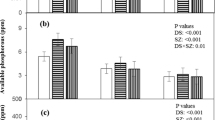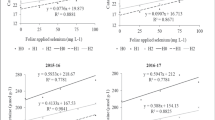Abstract
Zinc (Zn) deficiency and heat stress affect the productivity of cereal crops in many semi arid regions of the world. Zinc nutrition affects membrane integrity and activity of superoxide dismutase (SOD) enzymes which are also important to a plant’s ability to cope with high temperatures. Two experiments were conducted to examine the interaction between Zn nutrition and heat stress at two growth stages. Wheat was grown at deficient and adequate levels of Zn at 22/16°C before being exposed to a short period of high temperature (40/20°C). One experiment examined the response to a 3 day heat stress treatment at 10 days after anthesis and the second experiment examined the response to 6 days of heat stress in 30-day old seedlings. Varieties differing in thermotolerance and sensitivity to Zn deficiency were compared. Zinc deficiency and heat stress reduced kernel growth rates, kernel weight and grain yield and the greatest reductions were measured in Zn-deficient, heat stressed plants. The greater reduction in kernel growth rates from heat stress in Zn deficient plants occurred in both thermotolerant and sensitive varieties and was negatively associated with grain Zn concentration. Genetic differences in tolerance to Zn deficiency did not have consistent effects on the response to heat stress. Chlorophyll fluorescence and chlorophyll content were reduced and chloroplast ultrastructure was disrupted by heat stress and the effect was exacerbated by low supplies of Zn. While the responses to heat stress and low Zn were largely additive effects, the experiments demonstrated that low levels of Zn nutrition can exacerbate the adverse effects of short periods of heat stress on kernel growth and chloroplast function.








Similar content being viewed by others
References
Ainsworth EA, Rogers A, Leakey ADB (2008) Targets for crop biotechnology in a future high-CO2 and high-O3 world. Plant Physiol 147:13–19
Al-Khatib K, Paulsen GM (1990) Photosynthesis and productivity during high-temperature stress of wheat genotypes from major world regions. Crop Sci 30:1127–1132
Alloway BJ (2008) Zinc in soils and crop nutrition. International Zinc, Brussels
Almeselmani M, Deshmukh PS, Sairam RK, Kushwaha SR, Singh TP (2006) Protective role of antioxidant enzymes under high temperature stress. Plant Sci 171:382–388
Armond PA, Björkman O, Staehelin LA (1980) Dissociation of supramolecular complexes in chloroplast membranes: a manifestation of heat damage to the photosynthetic apparatus. Biochim Biophys Acta 601:433–442
Barnabas B, Jager K, Feher A (2008) The effect of drought and heat stress on reproductive processes in cereals. Plant Cell Environ 31:11–38
Berry J, Björkman O (1980) Photosynthetic response and adaptation to temperature in higher plants. Annu Rev Plant Physiol 31:491–543
Brown PH, Cakmak I, Zhang Q (1993) Form and function of zinc in plants. In: Robson AD (ed) Zinc in soil and plants. Kluwer Academic, Dordrecht, pp 93–106
Cakmak I (2000) Tansley Review No. 111: possible roles of zinc in protecting plant cells from damage by reactive oxygen species. New Phytol 146:185–205
Cakmak I, Marschner H (1988) Increase in membrane permeability and exudation in roots of zinc deficient plants. J Plant Physiol 132:356–361
Chen W, Yang X, He Z, Feng Y, Hu F (2007) Differential changes in photosynthetic capacity, 77K chlorophyll fluorescence and chloroplast ultrastructure between Zn-efficient and Zn-inefficient rice genotypes (Oryza sativa) under low zinc stress. Physiol Plant 132:89–101
Cui LJ, Li JL, Fan YM, Xu S, Zhang Z (2006) High temperature effects on photosynthesis, PSII functionality and antioxidant activity of two Festuca arundinacea cultivars with different heat susceptibility. Bot Stud 47:61–69
Dhindsa RS, Plumb-Dhindsa P, Thorpe TA (1981) Leaf senescence: correlated with increased levels of membrane permeability and lipid peroxidation, and decreased levels of superoxide dismutase and catalase. J Exp Bot 32:93–101
Easterling WE, Aggarwal PK, Batima P, Brander KM, Erda L, Howden SM, Kirilenko A, Morton J, Soussana J-F, Schmidhuber J, Tubiello FN (2007) Food, fibre and forest products. In: Parry ML, Canziani OF, Palutikof JP, van der Linden PJ, Hanson CE (eds) Climate change 2007: impacts, adaptation and vulnerability. Contribution of Working Group II to the Fourth Assessment Report of the Intergovernmental Panel on Climate Change. Cambridge University Press, Cambridge, UK
Foyer CH, Harbinson J (1994) Oxygen metabolism and the regulation of photosynthetic electron transport. In: Foyer CH, Mullineaux P (eds) Causes of photooxidative stresses and amelioration of defense in plants. CRC, Boca Raton, pp 1–42
Frei M, Wang Y, Ismail AM, Wissuwa M (2010) Biochemical factors conferring shoot tolerance to oxidative stress in rice grown in low zinc soil. Funct Plant Biol 37:74–84
Giannopolitis CN, Ries SK (1977) Superoxide dismutases. I. Occurrence in higher plants. Plant Physiology 59:309–314
Graham RD (1984) Breeding for nutritional characteristics in cereals. Adv Plant Nutr 1:57–102
Graham AW (2004) Effects of zinc nutrition and high temperature on the growth, yield and grain quality of wheat (Triticum aestivum L.), PhD, School of Agriculture, Food and Wine, The University of Adelaide. 297 p
Jenner CF (1982) Storage of starch. In: Loewus FA, Tanner W (eds) Encyclopedia of plant physiology. Springer, Berlin, pp 700–747
Jenner CG, Ugalde TD, Aspinal D (1991) The physiology of starch and protein deposition in the endosperm of wheat. Aust J Plant Physiol 18:211–226
Liu X, Huang B (2000) Heat stress injury in relation to membrane lipid peroxidation in creeping bentgrass. Crop Sci 40:503–510
McCain DC, Croxdale J, Markley JL (1989) Thermal damage to chloroplast envelope membranes. Plant Physiol 90:606–609
McDonald GK (2006) The effects of soil properties on variation in plant growth, grain yield and nutrient uptake. Aust J Exp Agric 46:93–105
McDonald GK, Graham RD, Lloyd J, Lewis J, Lonergan P, Khabas-Saberi H (2001) Breeding for improved zinc and manganese efficiency in wheat and barley. In: Rowe B (ed) 10th Australian Agronomy Conference, Hobart
McIntosh MS (1983) Analysis of combined experiments. Agron J 75:153–155
Paulsen GM (1994) High temperature response of crop plants. In: Boote KJ, Bennett JM, Sinclair TM, Paulsen GM (eds) Physiology and determination of crop yield. American Society of Agronomy, Crop science Society of America and Soil Science Society of America, Madison, pp 365–389
Peck AW, McDonald GK, Graham RD (2008) Zinc nutrition influences the protein composition of flour in bread wheat (Triticum aestivum L.). J Cereal Chem 47:266–274
Rashid A, Ryan J (2004) Micronutrient constraints to crop production in soils with Mediterranean-type characteristics: a review. J Plant Nutr 27:959–975
Reuter D, Robinson B (1997) Plant analysis: an interpretation manual. CSIRO, Melbourne
Reynolds ES (1963) The use of lead citrate at high pH as an electron opaque-stain in electron microscopy. J Cell Biol 17:208–212
Sayed OH (2003) Chlorophyll fluorescence as a tool in cereal crop research. Photosynthetica 41:321–330
Stone PJ, Nicolas ME (1994) Wheat cultivars vary widely in their responses to grain yield and quality to short periods of post-anthesis heat stress. Aust J Plant Physiol 21:887–900
Stone PJ, Nicolas ME (1995a) Effect of timing of heat stress during grain filling on two wheat varieties differing in heat tolerance. I. Grain growth. Aust J Plant Physiol 22:927–934
Stone PJ, Nicolas ME (1995b) A survey of the effects of high temperature during grain filling on yield and quality of 75 wheat cultivars. Aust J Agric Sci 46:475–492
Sundby C, Melis A, Mäenpää P, Andersson B (1986) Temperature-dependent changes in the antenna size of Photosystem II. Reversible conversion of Photosystem IIα to Photosystem IIβ. Biochim Biophys Acta 851:475–483
Wahid A, Gelani S, Ashraf M, Foolad MR (2007) Heat tolerance in plants: an overview. Environ Exp Bot 61:199–223
Wang H, Jin JY (2005) Photosynthetic rate, chlorophyll fluorescence parameters, and lipid peroxidation of maize leaves as affected by zinc deficiency. Photosynthetica 43:591–596
Wang H, Liu RL, Jin JY (2009) Effects of zinc and soil moisture on photosynthetic rate and chlorophyll fluorescence parameters of maize. Biologogia Plantarum 53:191–194
Weigel HJ (1983) The effect of high temperatures on leaf cells of Valerianella: relative heat stability of the tonoplast membrane of mesophyll vacuoles. Planta 159:398–403
Wrigley CW, Blumenthal CS, Gras PW, Barlow EWR (1994) Temperature variation during grainfilling and changes in wheat-grain quality. Aust J Plant Physiol 21:875–885
Yamane Y, Kashino Y, Koike H, Satoh K (1997) Increases in the fluorescence Fo level and reversible inhibition of Photosystem II reaction center by high-temperature treatments in higher plants. Photosynth Res 52:57–64
Yu Q, Osborne L, Rengel Z (1998) Micronutrient deficiency changes activities of superoxide dismutase and ascorbate peroxidase in tobacco plants. J Plant Nutr 21:1421–1437
Yu Q, Worth C, Rengel Z (1999) Using capillary electrophoresis to measure Cu/Zn superoxide dismutase concentration in leaves of wheat genotypes differing in tolerance to zinc deficiency. Plant Sci 143:231–239
Zadoks JC, Chang TT, Konzak CF (1974) A decimal code for the growth stages of cereals. Weed Res 14:415–421
Zarcinas BA, Cartwright B, Spouncer LR (1987) Nitric acid digestion and multi-element analysis of plant material by inductively coupled plasma spectrometry. Commun Soil Sci Plant Anal 18:131–146
Author information
Authors and Affiliations
Corresponding author
Additional information
Responsible Editor: Ismail Cakmak.
Rights and permissions
About this article
Cite this article
Peck, A.W., McDonald, G.K. Adequate zinc nutrition alleviates the adverse effects of heat stress in bread wheat. Plant Soil 337, 355–374 (2010). https://doi.org/10.1007/s11104-010-0532-x
Received:
Accepted:
Published:
Issue Date:
DOI: https://doi.org/10.1007/s11104-010-0532-x




